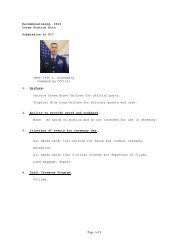The F-4D at the top of the - loran-history.info
The F-4D at the top of the - loran-history.info
The F-4D at the top of the - loran-history.info
Create successful ePaper yourself
Turn your PDF publications into a flip-book with our unique Google optimized e-Paper software.
<strong>The</strong> F-<strong>4D</strong> <strong>at</strong> <strong>the</strong> <strong>top</strong> <strong>of</strong> <strong>the</strong> picture, FA 788, is LORAN equipped (<strong>the</strong> towel rack on <strong>the</strong> back bone)<br />
and FG 815 is equipped with <strong>the</strong> laser design<strong>at</strong>or called "ZOTZ." <strong>The</strong> scope assy was mounted on<br />
<strong>the</strong> left canopy. <strong>The</strong> pilot would make <strong>the</strong> aiming limits on his canopy wi th a grease pencil as called<br />
out by <strong>the</strong> WSO. LORAN was <strong>the</strong> long range altern<strong>at</strong>ive to Comb<strong>at</strong> Skyspot which relied upon short<br />
range ground st<strong>at</strong>ions in Laos. <strong>The</strong>se photos are from about '71-'73.<br />
AN/ARN-92 LORAN-D equipment was fitted to Pave Phantom F-<strong>4D</strong>s. <strong>The</strong>y could be identified by a r<strong>at</strong>her<br />
prominent "towel-rail" antenna on <strong>the</strong> upper rear fuselage behind <strong>the</strong> rear cockpit. A total <strong>of</strong> 72 aircraft<br />
from blocks 32 and 33 were so equipped. In Vietnam, <strong>the</strong> primary mission <strong>of</strong> <strong>the</strong>se Pave Phantom F-<strong>4D</strong>s<br />
was <strong>the</strong> seeding <strong>of</strong> <strong>the</strong> Ho Chi Minh trail with sensors, which required <strong>the</strong> precise nighttime navig<strong>at</strong>ional<br />
capability provided by LORAN. <strong>The</strong> primary oper<strong>at</strong>ors <strong>of</strong> <strong>the</strong> "towel-rail" F-<strong>4D</strong>s were <strong>the</strong> 25th and 497th<br />
TFS <strong>of</strong> <strong>the</strong> 8th TFW and <strong>the</strong> 555th TFS <strong>of</strong> <strong>the</strong> 432nd TFW. Subsequently, <strong>the</strong>se planes were passed along<br />
to <strong>the</strong> 457th TFS <strong>of</strong> <strong>the</strong> 301st TFW, <strong>the</strong> 23rd TFS <strong>of</strong> <strong>the</strong> 52nd TFW, and <strong>the</strong> 704th TFS <strong>of</strong> <strong>the</strong> 924th TFG.<br />
I contacted <strong>the</strong> OV-10/FAC Museum and received this reply.<br />
“Add RF-4 to <strong>the</strong> list.<br />
Light Gap program used SR-71 gridded photography with a diamond stylus to mark <strong>the</strong> desired point on<br />
<strong>the</strong> photo. When dropped it provided a small hole. A calibr<strong>at</strong>ed light was placed under <strong>the</strong> photo and when<br />
it was centered on <strong>the</strong> hole <strong>the</strong> coordin<strong>at</strong>es were calibr<strong>at</strong>ed by computer. <strong>The</strong>re were three types <strong>of</strong> map<br />
coordin<strong>at</strong>es in play in SEA. Map, corrected map coordin<strong>at</strong>es, and true coordin<strong>at</strong>es. Loran and Sky Spot<br />
(SAC RBS) used true. Light Gap used true and thus could be put directly into <strong>the</strong> AN/ARN-92. When we<br />
figured this out we used Light Gap for a multitude <strong>of</strong> oper<strong>at</strong>ions. For B<strong>at</strong> 21 we had a computer gener<strong>at</strong>ed<br />
lists <strong>of</strong> targets th<strong>at</strong> we could use especially when we<strong>at</strong>her affected our oper<strong>at</strong>ion. One <strong>of</strong> <strong>the</strong> gre<strong>at</strong> things<br />
about Light Gap was it could be used by any aircraft th<strong>at</strong> had a AN/ARN-92. Several times we had<br />
form<strong>at</strong>ions <strong>of</strong> aircraft being led by an AN/ARN-92 equipped aircraft. One <strong>of</strong> <strong>the</strong> largest <strong>of</strong> this type <strong>of</strong> drop<br />
was lead by a RF-4 departing from <strong>the</strong> DaNang TACAN. <strong>The</strong> person who knew <strong>the</strong> most about how to use<br />
Light Gap was <strong>the</strong>n Lt. Donna Mooney.<br />
Ano<strong>the</strong>r way we used Loran was to find a target using <strong>the</strong> Pave Nail system, put <strong>the</strong> laser on it and<br />
“integr<strong>at</strong>e”, which would give you <strong>the</strong> <strong>loran</strong> coordin<strong>at</strong>es <strong>of</strong> <strong>the</strong> target. A <strong>loran</strong> equipped F-4 <strong>at</strong> 15M with a<br />
laser guided bomb would come in on <strong>the</strong> <strong>at</strong>tack heading you would provide and release <strong>the</strong> bomb 3.5 miles<br />
short <strong>of</strong> <strong>the</strong> target. At bomb release you would start an arc around <strong>the</strong> target and laser design<strong>at</strong>e <strong>the</strong> target.<br />
Bomb fall time was about 37 seconds. If <strong>the</strong> <strong>loran</strong> equipped F-4 had dumb bomb s we worked out a method<br />
with <strong>the</strong> 490 th where <strong>the</strong>y would drop triple 500 pounders and use “release advance” which put <strong>the</strong> center<br />
bomb directly on <strong>the</strong> target with <strong>the</strong> o<strong>the</strong>r two bracketing it to take out any spacing error. <strong>The</strong> advantage <strong>of</strong><br />
using <strong>the</strong>se types <strong>of</strong> deliveries was <strong>the</strong>re was no loc<strong>at</strong>ion error between <strong>the</strong> two aircraft. <strong>The</strong> <strong>loran</strong> chain<br />
had a tendency to drift <strong>the</strong> fur<strong>the</strong>r you got away from <strong>the</strong> st<strong>at</strong>ions (you used a master st<strong>at</strong>ion and two slave<br />
st<strong>at</strong>ions). But since you were taking a reading and using it within minutes <strong>the</strong>re was no target loc<strong>at</strong>ion error.<br />
You could also use <strong>the</strong> <strong>loran</strong> to fly a prescribed glide p<strong>at</strong>h to a point on <strong>the</strong> ground. This was used <strong>at</strong> least<br />
once to bring helicopters thru <strong>the</strong> we<strong>at</strong>her during rescue oper<strong>at</strong>ions.<br />
This also proved invaluable during search and rescue. Once you loc<strong>at</strong>ed <strong>the</strong> survivor you could put <strong>the</strong> laser<br />
on <strong>the</strong>m and get a good coordin<strong>at</strong>e. <strong>The</strong>n you could put a safety circle around <strong>the</strong> survivor(s) and begin<br />
delivering ordinance if needed. Several times we had to make <strong>loran</strong> deliveries <strong>of</strong> area denial munitions and<br />
riot agent using <strong>loran</strong>. This loc<strong>at</strong>ion capability really cut down <strong>the</strong> time needed to get <strong>the</strong> Sandys and Jollies<br />
over <strong>the</strong> survivors.<br />
After SEA I went to Eglin and particip<strong>at</strong>ed in several programs testing a ground laser system which also<br />
used <strong>loran</strong> for target loc<strong>at</strong>ion and design<strong>at</strong>ion. Th<strong>at</strong> was a scary concept because <strong>the</strong> bomb came from<br />
behind and passed over you on its way to <strong>the</strong> target. Eglin terrain was very fl<strong>at</strong> and you had to make sure<br />
<strong>the</strong> grass was short so th<strong>at</strong> your laser beam did not illumin<strong>at</strong>e <strong>the</strong> area directly in front <strong>of</strong> you – very<br />
spectacular. <strong>The</strong>re was also a <strong>loran</strong> guided bomb th<strong>at</strong> was being developed but th<strong>at</strong> was s<strong>top</strong>ped when <strong>the</strong><br />
war ended.<br />
<strong>The</strong> <strong>loran</strong> folks formed a group known, I think, as <strong>the</strong> Wild Goose Society. <strong>The</strong>y showed me some <strong>of</strong> <strong>the</strong>ir<br />
members accomplishments in <strong>the</strong> 80’s. One th<strong>at</strong> really stood out was <strong>the</strong> use a system very similar to <strong>loran</strong><br />
D for navig<strong>at</strong>ing large ships in San Francisco harbor.<br />
Chris, I hope some <strong>of</strong> this “brain dump” helps.<br />
VR Rick Atchison”





